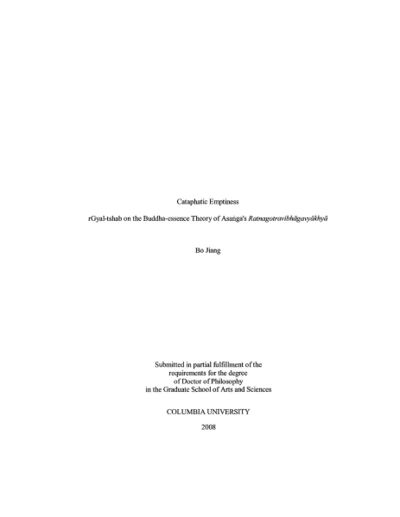Cataphatic Emptiness: rGyal-tshab on the Buddha-essence Theory of Asaṅga's Ratnagotravibhāgavyākhyā
< Books
| Line 32: | Line 32: | ||
**{{i|3. The Three Stages of Teaching according to the DIR|49}} | **{{i|3. The Three Stages of Teaching according to the DIR|49}} | ||
***{{i|Establishing the unique vehicle|49}} | ***{{i|Establishing the unique vehicle|49}} | ||
| − | ***{{i|As the distinctive presentation of the Prāsaṅgika-Mādhyamika viewpoint|54}} | + | ***{{i|As the distinctive presentation of the Prāsaṅgika-Mādhyamika <br>viewpoint|54}} |
**{{i|4. The ''Prajñāpāramitā-sūtra'' and the TGS|56}} | **{{i|4. The ''Prajñāpāramitā-sūtra'' and the TGS|56}} | ||
**{{i|5. The TGS as Being Definitive|62}} | **{{i|5. The TGS as Being Definitive|62}} | ||
| Line 40: | Line 40: | ||
***{{i|Refuting Buddha-essence as a permanent entity|72}} | ***{{i|Refuting Buddha-essence as a permanent entity|72}} | ||
***{{i|Refuting Buddha-essence as being endowed with twofold purities|77}} | ***{{i|Refuting Buddha-essence as being endowed with twofold purities|77}} | ||
| − | *{{i|2. Critique of the Mainstream Positions|81}} | + | **{{i|2. Critique of the Mainstream Positions|81}} |
| − | 'Gos-lo's position on Buddha-essence 84 | + | ***{{i|'Gos-lo's position on Buddha-essence|84}} |
| − | dGe-lugs-pa scholars' responses 89 | + | ***{{i|dGe-lugs-pa scholars' responses|89}} |
| − | + | **{{i|3. A Comparison with Critiques of "Original-enlightenment" theory in Modern Chinese Buddhism|94}} | |
| − | 3. A Comparison with Critiques of "Original-enlightenment" theory in Modern Chinese | + | ***{{i|A comparison of interpretations between 'Gos-lo and Zongmi|96}} |
| − | Buddhism 94 | + | ***{{i|Modern Chinese Critiques of "Original-enlightenment"|99}} |
| − | A comparison of interpretations between 'Gos-lo and Zongmi 96 | + | *{{i|Chapter 4: Analysis of the Title and Textural Structure|110}} |
| − | Modern Chinese Critiques of "Original-enlightenment" 99 | + | **{{i|1. The Title "''Mahāyānottaratantra''" and Its Implication|110}} |
| − | Chapter 4: Analysis of the Title and Textural Structure 110 | + | **{{i|2. The Seven Vajra-Like Bases|114}} |
| − | 1. The Title " | + | ***{{i|Two aspects|114}} |
| − | 2. The Seven Vajra-Like Bases 114 | + | ***{{i|rGyal-tshab's revision of rNgog-lo's "two wheels" theory |116}} |
| − | Two aspects 114 | + | ***{{i|The first three bases as ultimate fruition|118}} |
| − | rGyal-tshab's revision of rNgog-lo's "two wheels" theory 116 | + | ***{{i|The last four bases as cause and conditions|119}} |
| − | The first three bases as ultimate fruition 118 | + | 3. The Term "Ratnagotra" and the Textual Structure of RGV 121 |
| − | The last four bases as cause and conditions 119 | ||
| − | 3. The Term "Ratnagotra" and the Textual Structure | ||
4. rGyal-tshab on the Fourfold Ratnagotra as Cause and Conditions 124 | 4. rGyal-tshab on the Fourfold Ratnagotra as Cause and Conditions 124 | ||
The Element as a cause according to RGV I.16 124 | The Element as a cause according to RGV I.16 124 | ||
Revision as of 16:08, 30 April 2020
Abstract
This doctoral dissertation studies the Ratnagotravibhāga (Uttaratantra), the only surviving Indian Buddhist treatise on the Buddha-essence doctrine, by way of one of its major Tibetan commentaries, rGyal-tshab Dar-ma-rin-chen (1364-1432)'s Theg pa chen po rGyud bla ma'i ṭīkā. This project consists of three parts: a special edition of the first chapter of the Theg pa chen po rGyud bia ma'i ṭīkā, an English translation of the selected sections of that commentary, and a comparative analysis which follows six distinct lines of inquiry.
The six lines are: rGyal-tshab's doctrinal classification of the text; his critiques of absolutism, skepticism, and quietism in connection with diverse interpretations of the Buddha-essence doctrine in Tibetan traditions as well as a tentative comparison with critiques of the theory of "Original-enlightenment" in modern Chinese Buddhism; his analysis of the title of Tibetan version and the structure of the text; rGyal-tshab's
philosophical positions on reality, Element, and natural luminosity of the mind; his expositions of the tripartite Buddha-essence, its ten aspects, and the eighteen similes; and the notion "spiritual gene" understood by dGe-lugs-pas.
This comparative approach will provide a broader synthetic understanding of the role that Buddha-essence played as a doctrinal genre in Tibetan intellectual history.
| Citation | Jiang, Bo. "Cataphatic Emptiness: rGyal-tshab on the Buddha-Essence Theory of Asaṅga's Ratnagotravibhāgavyākhyā." PhD diss., Columbia University, 2008. |
|---|---|

